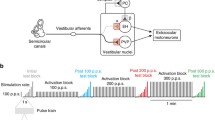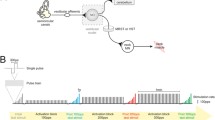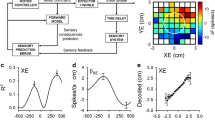Abstract
Motor systems are under a continuous adaptive process to maintain behavior throughout developmental changes and disease, a process called motor learning. Simple behaviors with easily measurable inputs and outputs are best suited to understand the neuronal signals that contribute to the required motor learning. Considering simple behaviors, the vestibulo-ocular reflex (VOR) allows quantification of its input and motor output and its neural circuitry is among the best documented. The main candidates for plastic change are the cerebellum and its target neurons in the brainstem. This review focuses on recent data regarding the involvement of the cerebellum in VOR motor learning. Learning can be divided into that acutely acquired over a period of hours and that chronically acquired over longer periods. Both acute and chronic learning have three phases named acquisition, consolidation, and retention. The cerebellar role in retention is disputed, but there is a consensus on the need of an intact cerebellum for acquisition. Data from neuronal recording, lesion studies and transgenic mouse experiments is complex but suggests that the signal representation in the cerebellum contains aspects of both motor output and sensory input. The cerebellum apparently uses different mechanisms for acute and chronic learning as well as for increases and decreases in VOR gain. Recent studies also suggest that the signal content in the cerebellum changes following learning and that the mechanisms used for chronic adaptation involve not only changes in a head velocity component but also in the efference copy of an eye movement command signal reaching Purkinje cells. This data leads to a new conceptual framework having implications for developing theories on the role of the cerebellum in motor learning and in the search for plastic elements within the VOR circuitry. For chronic learning we hypothesize that changes in the head velocity information traveling through the circuitry occur in parallel with changes in the integrator pathway and the efference copy pathway. We further propose that these changes are necessary to maintain the broadband characteristics of the learned behavior.
Similar content being viewed by others
References
Paige GD. Vestibuloocular reflex and its interactions with visual following mechanisms in the squirrel monkey. II. Response characteristics and plasticity following unilateral inactivation of horizontal canal. J Neurophysiol 1983; 49(1): 152–168.
Ito M. Historical review of the significance of the cerebellum and the role of purkinje cells in motor learning. Ann NY Acad Sci 2002; 978: 273–288.
Highstein SM, McCrea RA. The anatomy of the vestibular nuclei. Rev Oculomot Res 1988; 2: 177–202.
Dean P, Porrill J, Stone JV. Decorrelation control by the cerebellum achieves oculomotor plant compensation in simulated vesti-bulo-ocular reflex. Proc R Soc Lond B Biol Sci 2002; 269(1503): 1895–904.
Wolpert DM, Miall RC, Kawato M. Internal models in the cerebellum. Trends Cogn Sci 1998; 2: 338–347.
Takemura A, Inoue Y, Gomi H, Kawato M, Kawano K. Change in neuronal firing patterns in the process of motor command generation for the ocular following response. J Neurophysiol 2001; 86(4): 1750–1763.
Shidara M, Kawano K, Gomi H, Kawato M. Inverse-dynamics model eye movement control by Purkinje cells in the cerebellum. Nature 1993; 365(6441): 50–52.
Gomi H, Shidara M, Takemura A, Inoue Y, Kawano K, Kawato M. Temporal firing patterns of Purkinje cells in the cerebellar ventral paraflocculus during ocular following responses in monkeys I. Simple spikes. J Neurophysiol 1998; 80(2): 818–831.
Hirata Y, Yoshikawa Y, Blázquez PM, Highstein SM. Evaluation of the inverse dynamic model in cerebellum during visual-vestibular interactions at different VOR gains in squirrel monkeys. Computational Neuroscience Meeting 2004.
Hirata Y, Highstein SM. Acute adaptation of the vestibuloocular reflex: signal processing by floccular and ventral parafloccular Purkinje cells. J Neurophysiol 2001; 85: 2267–2288.
Blazquez PM, Hirata Y, Heiney SA, Green AM, Highstein SM. Cerebellar signatures of vestibulo-ocular reflex motor learning,. J. Neurosci 2003; 23: 9742–9751.
Yeo CH. Memory and the cerebellum. Curr Neurol Neurosci Rep 2004; 4(2): 87–89.
Hansel C, Linden DJ, D’Angelo E. Beyond parallel fiber LTD: the diversity of synaptic and non-synaptic plasticity in the cerebellum. Nat Neurosci. 2001; 4(5): 467–475.
van Alphen AM, De Zeeuw CI, Cerebellar LTD. facilitates but is not essential for long-term adaptation of the vestibulo-ocular reflex. Eur J Neurosci 2002; 16(3): 486–490.
Broussard DM, Kassardjian CD. Learning in a simple motor system. Learn Mem 2004; 11(2): 127–136.
Nagao S, Kitazawa H. Effects of reversible shutdown of the monkey flocculus on the retention of adaptation of the horizontal vestibulo-ocular reflex. Neuroscience 2003; 118: 563–570.
McElligott JG, Beeton P, Polk J. Effect of cerebellar inactivation by lidocaine microdialysis on the vestibuloocular reflex in goldfish. J Neurophysiol 1998; 79: 1286–1294.
Pastor AM, De La Cruz RR, Baker R. Cerebellar role in adaptation of the goldfish vestibuloocular reflex. J Neurophysiol 1994; 72: 1383–1394.
Kuki Y, Hirata Y, Blazquez PM, Heiney SA, Highstein SM. Differential retention of acutely and chronically acquired novel VOR gains. Neuroreport 2004; 15(6): 1007–1011.
Attwell PJ, Cooke SF, Yeo CH. Cerebellar function in consolidation of a motor memory. Neuron 2002; 34(6): 1011–1120.
Cooke SF, Attwell PJ, Yeo CH. Temporal properties of cerebellardependent memory consolidation. J Neurosci 2004; 24: 2934–2941.
Miles FA, Eighmy BB. Long-term adaptive changes in primate vestibuloocular reflex. I. Behavioral observations. J Neurophysiol 1980; 43(5): 1406–1425.
Boyden ES, Raymond JL. Active reversal of motor memories reveals rules governing memory encoding. Neuron 2003; 39(6): 1031–1042.
Lisberger SG. Neural basis for motor learning in the vestibuloocular reflex of primates. III. Computational and behavioral analysis of the sites of learning. J Neurophysiol 1994; 72(2): 974–98.
Lisberger SG, Pavelko TA, Bronte-Stewart HM, Stone LS. Neural basis for motor learning in the vestibuloocular reflex of primates. II. Changes in the responses of horizontal gaze velocity Purkinje cells in the cerebellar flocculus and ventral paraflocculus. J Neurophysiol 1994; 72: 954–973.
Ito M. Cerebellar long-term depression: Characterization, signal transduction, and functional roles. Physiological Reviews 2001; 81(3): 1143–1195.
Lisberger SG. Cerebellar LTD: a molecular mechanism of behavioral learning? Cell 1998; 20; 92(6): 701–704.
Llinas R, Lang EJ, Welsh JP. The cerebellum, LTD, and memory: alternative views. Learn Mem 1997; 3(6): 445–455.
Zhang Y, Partsalis AM, Highstein SM. Properties of superior vestibular nucleus flocculus target neurons in the squirrel monkey. I. General properties in comparison with flocculus projecting neurons. J Neurophysiol 1995; 73(6): 2261–2278.
Zhang Y, Partsalis AM, Highstein SM. Properties of superior vestibular nucleus neurons projecting to the cerebellar flocculus in the squirrel monkey. J Neurophysiol 1993; 69(2): 642–645.
Nakamagoe K, Iwamoto Y, Yoshida K. Evidence for brainstem structures participating in oculomotor integration. Science 2000; 288(5467): 857–859.
Rambold H, Churchland A, Selig Y, Jasmin L, Lisberger SG. Partial ablations of the flocculus and ventral paraflocculus in monkeys cause linked deficits in smooth pursuit eye movements and adaptive modification of the VOR. J Neurophysiol 2002; 87: 912–924.
Paige GD. Vestibuloocular reflex and its interactions with visual following mechanisms in the squirrel monkey. I. Response characteristics in normal animals. J Neurophysiol 1983; 49: 134–151.
Lisberger SG, Miles FA, Optican LM. Frequency-selective adaptation: evidence for channels in the vestibulo-ocular reflex? J Neurosci 1983; 3(6): 1234–1244.
Raymond JL, Lisberger SG. Behavioral analysis of signals that guide learned changes in the amplitude and dynamics of the vestibulo-ocular reflex. J Neurosci 1996; 16(23): 7791–7802.
Kramer PD, Shelhamer M, Peng GC, Zee DS. Context-specific short-term adaptation of the phase of the vestibulo-ocular reflex. Exp Brain Res 1998; 120(2): 184–192.
Kramer PD, Shelhamer M, Zee DS. Short-term adaptation of the phase of the vestibulo-ocular reflex (VOR) in normal human subjects. Exp Brain Res 1995; 106(2): 318–326.
Lisberger SG, Pavelko TA, Broussard DM. Neural basis for motor learning in the vestibuloocular reflex of primates. I. Changes in the responses of brain stem neurons. J Neurophysiol 1994; 72: 928–953.
Partsalis AM, Zhang Y, Highstein SM. Dorsal Y group in the squirrel monkey. II. Contribution of the cerebellar flocculus to neuronal responses in normal and adapted animals. J Neurophysiol 1995; 73(2): 632–50.
Author information
Authors and Affiliations
Corresponding author
Rights and permissions
About this article
Cite this article
Blazquez, P.M., Hirata, Y. & Highstein, S.M. The vestibulo-ocular reflex as a model system for motor learning: what is the role of the cerebellum?. Cerebellum 3, 188–192 (2004). https://doi.org/10.1080/14734220410018120
Received:
Accepted:
Issue Date:
DOI: https://doi.org/10.1080/14734220410018120




